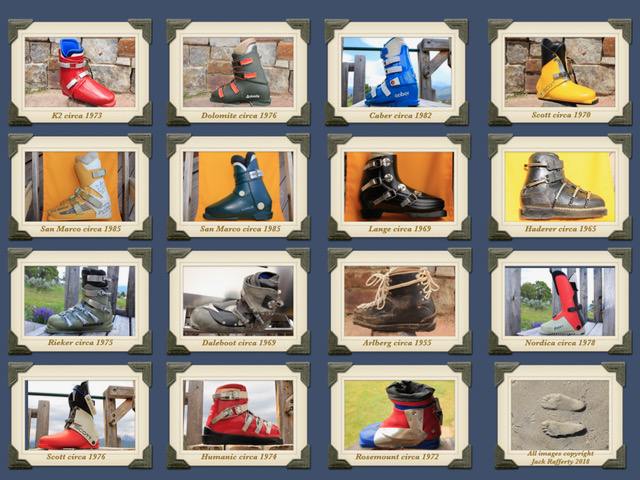
The boot world’s rich diversity when unconstrained by standards. [Photo by Jack Rafferty.]
In the 1970’s, prior to the adoption of the first ski boot sole standard, boot makers were free to concoct any sort of sole they might imagine. Many skiers still used leather boots with laminated soles, even after the industry largely moved on to injected plastic, which enabled shapes and sole patterns leather couldn’t duplicate.
This incoherent jumble of boot designs showed no lack of imagination, but little consideration for how they might interact with a binding. Bindings were likewise free from any standards that might have limited the creativity of their designs, many of which were crafted specifically to reduce or eliminate the role of the boot.
Remember plate bindings, the scourge of any freestyle skiers condemned to ski them? They could release in any direction, a talent they would often demonstrate several times a day. The multi-directional release function was made possible because the boot played no part in it; the release/retention function was performed by the interaction of an indentation in the plate and pressure from a spring mounted on the ski.
Other notable binding designs that tried to reduce or eliminate the boot’s role in the release system included Spademan, Cubco, Marker Simplex, Salomon 444/555 and the Allsop. The Spademan and Cubco added hardware to the boot that allowed it to connect with the binding. For the Simplex or Allsop to work, the boot also had to be modified to interface with the binding, using notches in the toe for the Marker and fashioning a socket in the boot sole for a matching post on the Allsop binding.
If this sounds a bit confusing, it was. Incompatible systems were being created all the time, often with the blessing of experts. Skiers – and the shops who served them – would mix and match toe pieces and heels from competing brands as if they were made for each other. In the long-thong era, mating a Look Nevada toe with a Marker turntable heel was a popular combo. I wore mine with a 6’6” leather strap wrapped thrice around my ankles, essentially defying the system to release.
During this era, cartoonists typically portrayed skiers as seated before an open fire sporting a leg cast, and the stereotype wasn’t unfair. This Tower of Babel of boots and bindings and the cavalier way they were assembled assured that tibias would snap like twigs. It was to tame this rough-and-tumble menagerie that Alpine boot and binding standards were developed in the 1970’s and implemented by the early 80’s.
The pivotal standard was for the boot sole, creating a dependable constant binding designers could count on. The German standards institute, the DIN, was the first to codify it, in 1978. Every national standards organization would follow suit, culminating in its adoption by the International Standards Organization as ISO 5355.
The universal implementation of ISO 5355 and the binding specifications it made possible led to a precipitous plunge in lower leg fractures. Any boot would fit correctly in any binding. Total chaos had been replaced with nearly foolproof coherence. (A persistent plague of knee ligament injuries assumed the role of skiing’s archetypical injury, but that’s a topic for another day.)

To order one of Jack Rafferty’s posters of vintage boots, contact him at thotics@mindspring.com.
There was just one, seemingly innocuous matter to attend to. Boots used for Alpine Touring needed a heavily treaded sole and a means of attachment to ultra-light touring bindings that no one could possibly confuse with an Alpine set-up. The needs of the then relatively tiny AT community were addressed with ISO 9523:2015, so both the backcountry and the in-resort communities were protected from the dangers of component incompatibility.
Ah, but Nature, of which mankind is a part, abhors a vacuum. People quite naturally decided that, all things considered, they wanted to ski both in-resort and OB conditions without changing boots. Several boot makers concocted cross-over models that would work with tech fittings for climbing, yet retained the dimensions of Alpine boot soles to preserve functionality with Alpine bindings. To further support backcountry usage, more tread was added to the sole and the forefoot was rockered to make walking easier.
It was clear the new walking sole was what skiers wanted, but there was no standard to support their use. While they would work with touring bindings (if they had tech fittings), they wouldn’t work with any Alpine binding without a toe-height adjustment. The free-for-all attitude of the old days began to creep back into consumer consciousness: why not use this (AT-inspired) boot with that (Alpine) binding? What could be the harm?
In a word, plenty. A spike in reported injuries on incompatible equipment evinced a clear need for a revised boot sole standard to cover what would become known as GripWalk soles, and today we finally have one in a revised version of ISO 5355. (BTW, it’s normal for markets to move faster than standard development, which is inherently slow and deliberate.) But the end of commercial confusion over what binding will work with which boot hasn’t totally resolved the issue. Standards may define the status quo and set the direction for the immediate future, but they don’t have the power to require the past to agree with their dicta. (That’s kind of the point, defining what is obsolete.) So there are still tens of thousands of Alpine bindings in use that are not compatible with a GripWalk sole.
If we were dealing with a normal ski market, this might be a self-correcting problem. Shop technicians would know not to assemble a faulty system and would winnow them out of the population. But shop techs may never see what some clever consumers create. Internet shoppers may not encounter any resistance as they build a ski/boot/binding system that is guaranteed to fail.
The simplest way to avoid making a grievous mistake is taking any system you’ve assembled from a mix of old and new components to a specialty shop for evaluation. This is how our little industry has traditionally dealt with product recalls or obsolescence: allow the retailer community to act as the filtration device.
Before dismounting from my weekly pulpit, I want to underscore the perils of sending well-intentioned but under-informed novices out to the backcountry. If you don’t want the backcountry to be where your ski experience ends, then don’t make it the place where it begins. Skiing is an inherently risky sport, risks that can only be mitigated by learning basic skills on appropriate equipment. To leapfrog over all apprenticeship via self-instruction is not only dangerous to the person choosing this route, it imperils all in his or her vicinity when in the backcountry.

